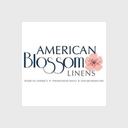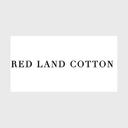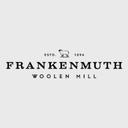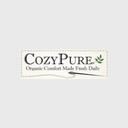Your comforter is something you spend time with every day (err, night), so it should matter where it’s made! There are a lot of dumpy comforter brands out there, so we set out to find all the comforters made in the USA and expose the big brands that aren’t made here too. We also list some shopping tips at the end to help you find the country of origin.
Complete List of Comforter & Duvet Brands Made in the USA

Brand name: American Blossom Linens
Headquarters: Thomaston, GA
States manufacturing in: GA, NC, SC, TX,
American Blossom Linens has a duvet set that is made from 100% organic cotton for a reasonable price. They are very transparent with their supply chain too, which we love. They source their cotton from farms in Texas and do their sewing, weaving, finishing, and other activities in the Carolinas and Georgia. The family behind this brand has been in manufacturing for over 120 years.

Authenticity50 is a bedding and bath brand that is making everything from sheets to towels, and yes, duvets too. They make a Comfort Temp Duvet that is so good that they regularly sell out every season. Make sure to get the A50 Duvet Cover with it, too. This is the comforter that Mike has on his bed.

Not quite a comforter or duvet, but Victor Mill makes some high-quality quilts that we thought worth mentioning here.

Red Land Cotton makes great duvet covers in plain white and more colorful varieties. Everything is 100% cotton sourced from their family farm in North Alabama, and they keep their entire supply chain extremely local.

Frankenmuth Woolen Mill has been manufacturing in the U.S. since 1894 and has a very popular wool comforter that is hand-tied and organic. Their wool is sourced from ranches in California.

CozyPure is an American bedding brand that makes a great hand-tied wool comforter made from 100% chemical-free, pure wool. Unfortunately, they do have some imported materials it seems, so we wanted to call that out. Everything else is manufactured in their Virginia facility though.
Mike’s YouTube Video on American Made Comforters & Duvets
How to Find Comforters & Duvets Made in the USA
Finding the country of origin can be really frustrating, especially when you’re shopping online and can’t look at the tag. So, here are some tips for finding U.S. made comforters and duvets.
For all our advice on shopping for American made products, make sure to head to our made in the USA labeling explainer guide.
Materials
Comforters and duvets typically have one of a few fillings in them, so let’s break down each one and what the shell is normally made of as well.
Wool
One of the most popular filling materials for duvets and comforters is wool, since it keeps really warm. The U.S. is outside the top ten countries in terms of global production, but still has a sizeable number of ranchers that are raising sheep for our local supply chain. It typically comes down to the type of sheep (the French Merino is popular in the American West), so just give the brand a call and double-check their sheep sourcing if they aren’t transparent about it on their website.
Down Feathers
Higher-end duvets can be filled with goose feathers, which has historically been very tough to source in the U.S. Asia, European countries, and Canada have dominated the goose down market for a long time and it doesn’t seem to be changing any time soon. Be wary about down feather duvets; they likely aren’t sourced domestically.
Cotton
Cotton isn’t as warm as the materials I talked about above, so you won’t find it in as many comforters. However, cotton is plentiful in the U.S., so you should have no problem finding 100% made in the USA comforters if you’re looking at this material. You might just need an extra blanket or two on the bed.
Polyester
Polyester blends are often used in the shell for several comforters and duvets. China leads global production of polyester, followed by several Asian countries like Taiwan and India. However, the United States holds its own as well, producing around 1.28 million metric tons of polyester per year. So, if you see this material when you’re shopping, it’s a bit of a toss-up for where it’s sourced from, but there are plenty of American sourcing options for polyester.
Labeling
Title 19, Chapter 4, Section 1304 of the U.S. Code states that all imported products must be labeled with their country of origin on the product or packaging. So, lucky for us, we have some U.S. legislation fighting for us while we’re shopping. However, that law only applies to the physical product – not their website or other materials.
So, in today’s age of e-commerce shopping, it’s up to the brand whether or not they want to disclose where their products are made on their website.
When in doubt, I always like to shoot them an email or pick up the phone and call them to find out, 1) where are they manufacturing, and 2) where are they sourcing their materials from.
Final Tips
Let’s go over some last-minute tips for finding comforters, duvets, and other products made in the USA.
First, just because the company has an American flag in their logo or on their products, doesn’t mean they are made in the USA. This is not regulated.
Second, watch out for qualifying language like “assembled in the USA” or “stitched in the USA.” You want to look for “made in the USA” language specifically. Anything other than that is a good tip that they might not be sourcing all of their materials domestically.
Comforters & Duvets Not Made in the USA
We also like to keep a running list of popular brands that aren’t made here. We’ll keep this updated as we find more.
- MagicLinen – sourcing from Western Europe, India, Pakistan, and other countries
- Benji Sleep
- Sheet Society – made in China
- CozyLux
- Boll & Branch – some of their products are finished in the U.S., but cotton is sourced from India and they have other sourcing partners in Portugal and Belgium
- Brooklinen – made in Portugal with materials from Belgium and France
- Amazon Basics – made in Pakistan and China primarily
- Parachute – made in Turkey
- Slumber Cloud – mainly sources materials from Germany and Asia, and most manufacturing happens in Asia
- Bare Home
Related Research
For more bedroom and textiles research, head to our guides below.

